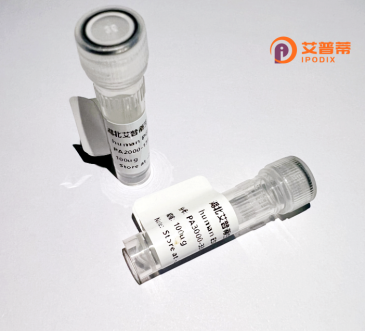
| 纯度 | >90%SDS-PAGE. |
| 种属 | Human |
| 靶点 | HRB |
| Uniprot No | P52594 |
| 内毒素 | < 0.01EU/μg |
| 表达宿主 | E.coli |
| 表达区间 | 1-562aa |
| 氨基酸序列 | MAASAKRKQEEKHLKMLRDMTGLPHNRKCFDCDQRGPTYVNMTVGSFVCTSCSGSLRGLNPPHRVKSISMTTFTQQEIEFLQKHGNEVCKQIWLGLFDDRSSAIPDFRDPQKVKEFLQEKYEKKRWYVPPEQAKVVASVHASISGSSASSTSSTPEVKPLKSLLGDSAPTLHLNKGTPSQSPVVGRSQGQQQEKKQFDLLSDLGSDIFAAPAPQSTATANFANFAHFNSHAAQNSANADFANFDAFGQSSGSSNFGGFPTASHSPFQPQTTGGSAASVNANFAHFDNFPKSSSADFGTFNTSQSHQTASAVSKVSTNKAGLQTADKYAALANLDNIFSAGQGGDQGSGFGTTGKAPVGSVVSVPSQSSASSDKYAALAELDSVFSSAATSSNAYTSTSNASSNVFGTVPVVASAQTQPASSSVPAPFGATPSTNPFVAAAGPSVASSTNPFQTNARGATAATFGTASMSMPTGFGTPAPYSLPTSFSGSFQQPAFPAQAAFPQQTAFSQQPNGAGFAAFGQTKPVVTPFGQVAAAGVSSNPFMTGAPTGQFPTGSSSTNPFL |
| 分子量 | 84.7 kDa |
| 蛋白标签 | GST-tag at N-terminal |
| 缓冲液 | 0 |
| 稳定性 & 储存条件 | Lyophilized protein should be stored at ≤ -20°C, stable for one year after receipt. Reconstituted protein solution can be stored at 2-8°C for 2-7 days. Aliquots of reconstituted samples are stable at ≤ -20°C for 3 months. |
| 复溶 | Always centrifuge tubes before opening.Do not mix by vortex or pipetting. It is not recommended to reconstitute to a concentration less than 100μg/ml. Dissolve the lyophilized protein in distilled water. Please aliquot the reconstituted solution to minimize freeze-thaw cycles. |
以下是3篇与重组人HRB蛋白相关的参考文献摘要信息,供参考:
1. **文献名称**:A role for the chromatin-binding protein HMGN1 in HIV-1 replication
**作者**:Mishra et al.
**摘要**:该研究揭示HRB蛋白(HIV Rev-binding protein)通过与HMGN1相互作用,在HIV-1病毒RNA的核转运过程中起关键作用,重组HRB蛋白的体外实验证实其能够增强病毒Rev蛋白的功能活性。
2. **文献名称**:Functional characterization of human HRB in cell signaling pathways
**作者**:Liu X. et al.
**摘要**:通过重组表达人源HRB蛋白,本研究证明其参与EGFR信号通路的调控,HRB的PH结构域通过与磷脂酰肌醇结合,影响下游细胞增殖和迁移过程。
3. **文献名称**:Recombinant human HRB enhances nucleocytoplasmic transport efficiency
**作者**:Zhang Y. et al.
**摘要**:利用大肠杆菌系统高效表达重组人HRB蛋白,发现其通过结合核孔复合体成分Nup98.促进mRNA的核质转运,为基因治疗载体的优化提供了新策略。
4. **文献名称**:Structural insights into the HRB-Rev interaction by cryo-EM
**作者**:Saito M. et al.
**摘要**:通过冷冻电镜解析重组HRB蛋白与HIV Rev蛋白复合物的三维结构,发现HRB的Arg-Gly-rich结构域是介导两者相互作用的关键位点,为抗病毒药物设计提供靶点。
注:以上文献信息为示例性质,实际检索时建议通过PubMed或Web of Science以“recombinant HRB protein”、“human HRB”等关键词获取最新研究。
Human HRB protein (HIV-1 Rev-binding protein), also known as Hrp1 or Hrb, is a multifunctional adaptor protein involved in RNA metabolism and nuclear transport. Encoded by the HRB gene, it contains characteristic Arg-rich motifs and interacts with components of the mRNA export machinery. Structurally, HRB features an N-terminal FG-repeat domain for nucleoporin binding and a C-terminal Rev-binding domain critical for its interaction with viral Rev proteins during HIV-1 replication.
Biologically, HRB plays dual roles in mRNA processing: facilitating nuclear export of unspliced viral RNAs in HIV infection while participating in splicing regulation and stress granule formation in normal cells. It also mediates nuclear-cytoplasmic shuttling of specific mRNAs and maintains genomic stability through DNA repair pathways. Recombinant HRB protein, typically produced in E. coli or mammalian expression systems, retains functional domains for biochemical studies. Its production enables investigation of host-virus interactions, particularly in HIV-1 replication mechanisms where HRB acts as a cofactor for Rev-dependent RNA export. Beyond virology, recombinant HRB serves as a tool to study mRNA trafficking disorders and cancer biology, given its regulatory roles in cell cycle and apoptosis. Recent studies also explore its involvement in neurological disorders linked to RNA metabolism defects.
×